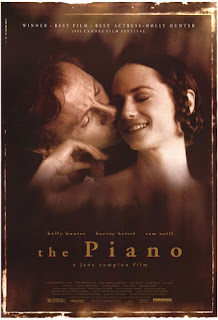November 16th: THE ENGLISH PATIENT (Anthony Minghella, 1996)
NOTE: This film will be projected in the high-definition Blu-ray format.
Near the end of World War II, a grief-stricken nurse takes care of a badly-burned man of unknown origin who recounts his adventures as an archeologist in the Sahara Desert.
The English Patient is a historical fiction novel by Sri Lankan writer Michael Ondaatje, and a winner of the prestigious Man Booker prize for literature. Anthony Minghella was a British award-winning playwright with only two small-scale films to his name when he approached independent producer Saul Zaentz (Amadeus, One Flew Over The Cuckoo's Nest) with the idea of making a big screen version of the story.
Minghella spent an extensive amount of time on the script, as the novel itself had very little dialoguettpniiea and was viewed by many as unadaptable due to its stream-of-consciousness, non-linear style. He kept in close contact with Ondaatje, and the two would meet with Zaentz after every draft of the screenplay to discuss the process.
Disputes with 20th Century Fox executives over casting eventually forced Zaentz to move the project to independent studio Miramax, who were slowly becoming the kings of releasing ambitious films by lesser-known/foreign directors. Ralph Fiennes, fresh from his Oscar-nominated work in Schindler's List, was cast in the lead, alongside fellow British thespians Kristin Scott Thomas (Four Weddings And A Funeral ), Colin Firth (The King's Speech) and Naveen Andrews (TV's Lost), as well as French actress Juliette Binoche (Three Colors: Blue), and Willem Dafoe (The Life Aquatic).
Minghella's behind-the-camera crew included cinematographer John Seale and and two-time Oscar-winning production designer Stuart Craig. The decision was made to shoot the flashback/desert scenes in bold, warm colors, while the present action is in cool colors and mostly diffused light, resulting in the past seeming more "real" and vivid, mimicking the title character's mental state. The film was shot in Tunisia and various cities in Italy, recreating locations that included Egypt and Libya.
Because of the multicultural cast of characters and settings, Lebanese composer Gabriel Yared drew from Arabic and Hungarian music as well as old-fashioned epic Hollywood grandeur for his evocative musical score. Legendary editor Walter Murch (Apocalypse Now), cutting digitally for the first time, counted over forty time-frame transitions over the film's length, in the process radically altering the original order of scenes as written in the script.
Upon release the film was met with mostly positive, occasionally rapturous reviews, with the New York Times, Los Angeles Times, and Time magazine all proclaiming it the best film of the year. It received a whopping 12 Academy Award nominations, winning 9 (a tie for the second highest tally) including Best Picture, Direction, Cinematography, Supporting Actress (Binoche), Editing, and Original Score.
Running time is approx. 2 hrs, 30 min.
Near the end of World War II, a grief-stricken nurse takes care of a badly-burned man of unknown origin who recounts his adventures as an archeologist in the Sahara Desert.
The English Patient is a historical fiction novel by Sri Lankan writer Michael Ondaatje, and a winner of the prestigious Man Booker prize for literature. Anthony Minghella was a British award-winning playwright with only two small-scale films to his name when he approached independent producer Saul Zaentz (Amadeus, One Flew Over The Cuckoo's Nest) with the idea of making a big screen version of the story.
Minghella spent an extensive amount of time on the script, as the novel itself had very little dialoguettpniiea and was viewed by many as unadaptable due to its stream-of-consciousness, non-linear style. He kept in close contact with Ondaatje, and the two would meet with Zaentz after every draft of the screenplay to discuss the process.
Disputes with 20th Century Fox executives over casting eventually forced Zaentz to move the project to independent studio Miramax, who were slowly becoming the kings of releasing ambitious films by lesser-known/foreign directors. Ralph Fiennes, fresh from his Oscar-nominated work in Schindler's List, was cast in the lead, alongside fellow British thespians Kristin Scott Thomas (Four Weddings And A Funeral ), Colin Firth (The King's Speech) and Naveen Andrews (TV's Lost), as well as French actress Juliette Binoche (Three Colors: Blue), and Willem Dafoe (The Life Aquatic).
Minghella's behind-the-camera crew included cinematographer John Seale and and two-time Oscar-winning production designer Stuart Craig. The decision was made to shoot the flashback/desert scenes in bold, warm colors, while the present action is in cool colors and mostly diffused light, resulting in the past seeming more "real" and vivid, mimicking the title character's mental state. The film was shot in Tunisia and various cities in Italy, recreating locations that included Egypt and Libya.
Because of the multicultural cast of characters and settings, Lebanese composer Gabriel Yared drew from Arabic and Hungarian music as well as old-fashioned epic Hollywood grandeur for his evocative musical score. Legendary editor Walter Murch (Apocalypse Now), cutting digitally for the first time, counted over forty time-frame transitions over the film's length, in the process radically altering the original order of scenes as written in the script.
Upon release the film was met with mostly positive, occasionally rapturous reviews, with the New York Times, Los Angeles Times, and Time magazine all proclaiming it the best film of the year. It received a whopping 12 Academy Award nominations, winning 9 (a tie for the second highest tally) including Best Picture, Direction, Cinematography, Supporting Actress (Binoche), Editing, and Original Score.
Running time is approx. 2 hrs, 30 min.











Comments
Post a Comment